Fiber Optic Tech
What is ROADM?
Reconfigurable Optical Add-Drop Multiplexer (ROADM) is a device or equipment used in dense wavelength division multiplexing (DWDM) systems. Through remote reconfiguration, it can dynamically add or drop service wavelengths to achieve flexible scheduling of services.
Every ROADM node contains a network node interface (NNI) and a user network interface (UNI). NNI interconnects DWDM signals from/to multiple transmission directions, and these DWDM signals are switched between transmission directions at wavelength granularity. UNI down""s signals destined for this node at wavelength granularity and up""s signals from this node. In order to achieve non-blocking wavelength switching and up""/down"", the new generation ROADM nodes are required to have the characteristics of colorless, directionless and contentionless.
ROADM nodes usually consist of wavelength selective switches (WSS) and other modules. The CDC function depends on the structure of the ROADM node, while the flexible bandwidth function depends on the key module WSS. Three mainstream WSS technology solutions currently are MEMS, Liquid Crystal On (LC) and Liquid Crystal On Silicon (LCOS). LCOS WSS natively supports flexible bandwidth functions. LC WSS can also support flexible bandwidth functions after optimized design, but MEMS WSS doesn’t. The following are five ROADM structures.
Structure of CD ROADM
ROADM structure #1 is shown in Figure 1. The NNI is composed of 1×N port WSS. A 3D ROADM node requires two WSS. The UNI side contains several up""/down"" modules. Each down"" module consists of two 1×N port WSS connected back to back. Each up"" module consists of a 1×N port WSS and a optical splitter connected back to back. It can be seen from the function of 1×N port WSS that ROADM structure can support colorless and non-directional up""/down"" of signals. However, when the number of the ROADM node is more than the number of up""/down"" modules on the UNI side, wavelength competition will occur at the position in the red circle in the figure. Perhaps we can solve the wavelength contention problem by increasing the number of up""/down"" modules, but this will be costly. Therefore, this ROADM structure cannot fully meet the CDC ROADM function and can only be determined as CD ROADM.
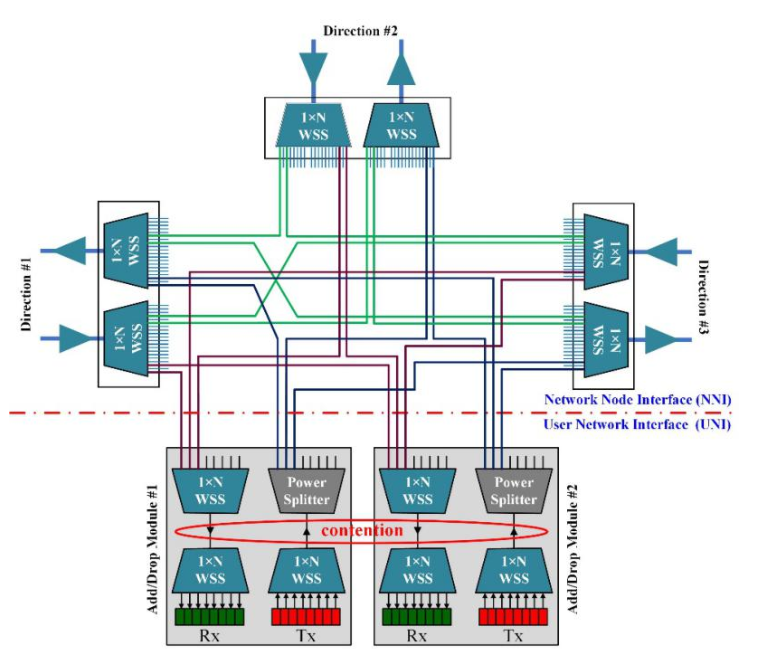
Figure 1. ROADM#1
ROADM Structure Based on Multicast Switch MCS
The structure ROADM #2 is the same as ROADM#1 in that its UNI side is also composed of 1×N port WSS, and the UNI side is composed of multicast optical switch MCS. An M×N port MCS switch has M input ports and N output ports, and is composed of M 1×N port optical splitters and N M×1 port optical switches. The optical signal is input from one of the input ports and is first divided into N parts by the optical splitter and broadcast to all optical switches; then the optical switch corresponding to the target output port to receive the optical signal, while other optical switches don’t receive the optical signal.
According to the functions of 1×N port WSS and MCS, ROADM #2 can realize the CDC function. However, the optical splitter in MCS produces too much loss when splitting and broadcasting, so an optical amplifier array is needed to supplement the optical power. But configuring an optical amplifier array is quite expensive.
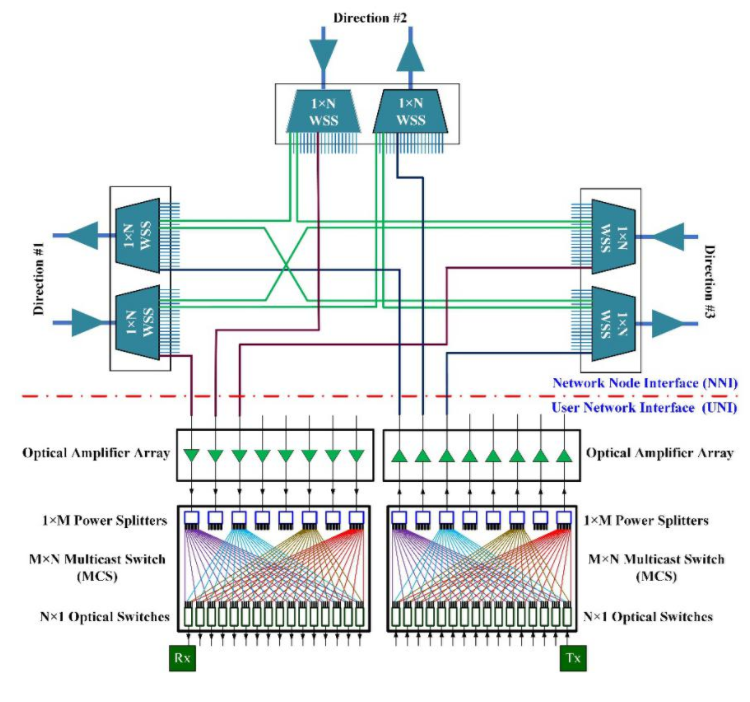
Figure 2. ROADM #2
CDC-ROADM Based on WSS
Structure of ROADM #3 as shown in figure 3. The difference from the previous structure is still on the UNI side. It uses two M×N port WSS to implement CDC (colorless, directionless and contentionless) up""/down"" of signals. An M×N port WSS has M input ports and N output ports. It can switch any wavelength combination in any input port to any output port. The loss of M×N port WSS is much smaller than MCS, so there is no need to configure an optical amplifier.
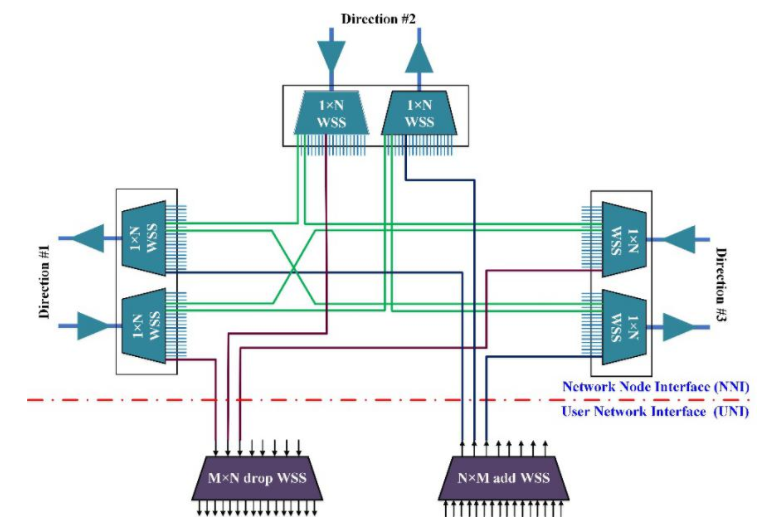
Figure 3. ROADM #3
ROADM Structure Based on WSS+AWG
In the down"" module of ROADM structure #4, all wavelengths are firstly demultiplexed by AWG, and then all the demultiplexed ports are switched to the down"" port by 3D MEMS optical switch. The working principle of up"" module is similar to the down"" module. This ROADM structure can implement the CDC function and provide 100% backup ports for all wavelengths reaching or originating from this node.
Figure 4. ROADM #4
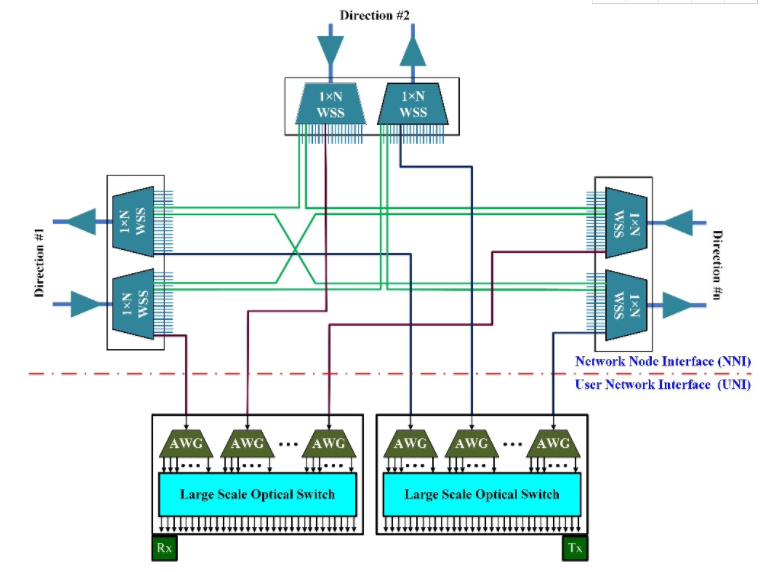
ROADM Structure Based on adWSS
Structure of ROADM #5 is shown in Figure 5. It is somewhat similar to the structure of Figure 4. The difference is that the M×N port WSS is replaced by the M×N port adWSS. adWSS is the abbreviation of up""/down"" wavelength selective switch. It has M input ports and N output ports. All input ports are DWDM ports, and all output ports are single wavelength ports. adWSS can switch any wavelength from any input port to any output port.
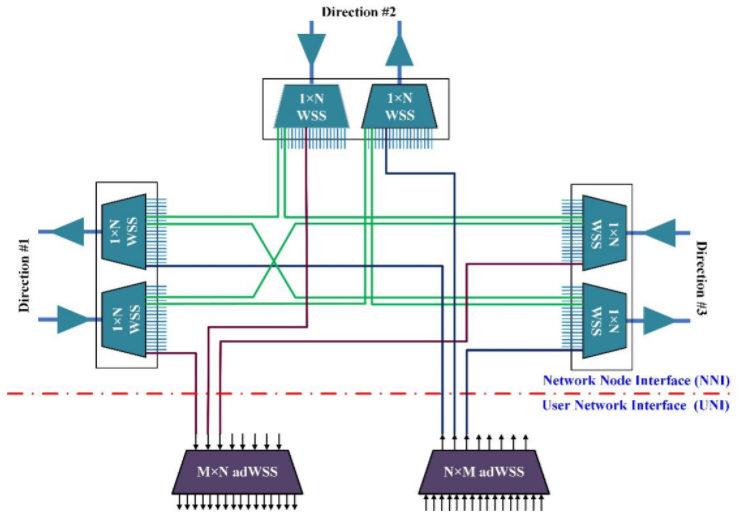
Figure 5. ROADM #5
Which Structure is Better?
The NNI side of all structures is built with 1×N port WSS, the difference is on the UNI side. ROADM #1 only supports colorless and directionless functions and is identified as a CD ROADM. ROADM #2 is a CDC ROADM, but due to the high loss of the optical splitter, an optical amplifier array is required, which is costly. ROADM #3 introduces M×N port WSS to the UNI side to realize the CDC function. At the same time, the number of down"" ports provided by M×N WSS (the typical number of ports is 8×24) is far from enough for high-dimensional ROADM nodes. ROADM #4 has CDC functionality and provides 100% up""/down"" port backup. However, 100% spare transceiver modules (Rx and Tx) are not cost-effective. The UNI side of ROADM #5 needs to use adWSS. A typical adWSS has 8×128 ports, which means that it is enough to configure two adWSS in an 8-dimensional ROADM node. However, adWSS technology is not yet mature and is still far from commercial use.
To sum up, ROADM #2 is the current mainstream CDC ROADM solution; ROADM #3 is a potential competitor, provided that costs decrease and more suppliers emerge; ROADM #5 will be the most promising when the technology matures. Competitive solutions.



















